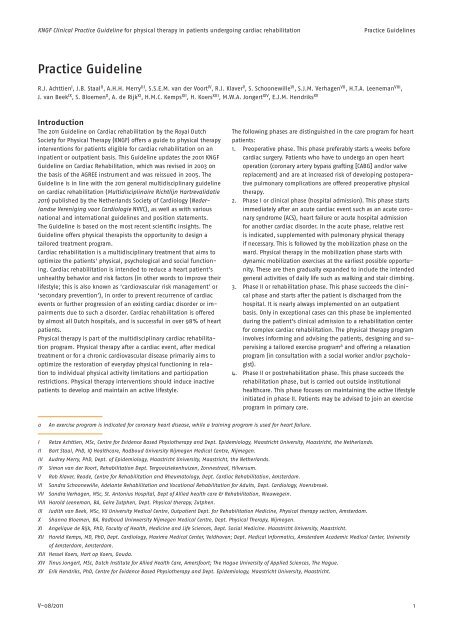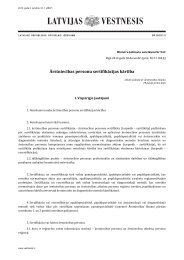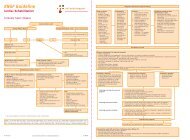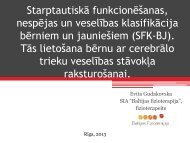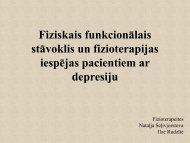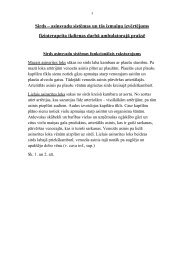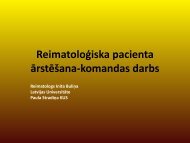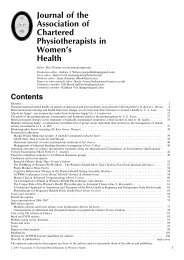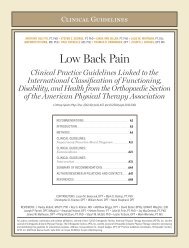KNGF Guideline Cardiac rehabilitation
KNGF Guideline Cardiac rehabilitation
KNGF Guideline Cardiac rehabilitation
Create successful ePaper yourself
Turn your PDF publications into a flip-book with our unique Google optimized e-Paper software.
<strong>KNGF</strong> Clinical Practice <strong>Guideline</strong> for physical therapy in patients undergoing cardiac <strong>rehabilitation</strong><br />
Practice <strong>Guideline</strong>s<br />
Practice <strong>Guideline</strong><br />
R.J. Achttien I , J.B. Staal II , A.H.H. Merry III , S.S.E.M. van der Voort IV , R.J. Klaver V , S. Schoonewille VI , S.J.M. Verhagen VII , H.T.A. Leeneman VIII ,<br />
J. van Beek IX , S. Bloemen X , A. de Rijk XI , H.M.C. Kemps XII , H. Koers XIII , M.W.A. Jongert XIV , E.J.M. Hendriks XV<br />
Introduction<br />
The 2011 <strong>Guideline</strong> on <strong>Cardiac</strong> <strong>rehabilitation</strong> by the Royal Dutch<br />
Society for Physical Therapy (<strong>KNGF</strong>) offers a guide to physical therapy<br />
interventions for patients eligible for cardiac <strong>rehabilitation</strong> on an<br />
inpatient or outpatient basis. This <strong>Guideline</strong> updates the 2001 <strong>KNGF</strong><br />
<strong>Guideline</strong> on <strong>Cardiac</strong> Rehabilitation, which was revised in 2003 on<br />
the basis of the AGREE instrument and was reissued in 2005. The<br />
<strong>Guideline</strong> is in line with the 2011 general multidisciplinary guideline<br />
on cardiac <strong>rehabilitation</strong> (Multidisciplinaire Richtlijn Hartrevalidatie<br />
2011) published by the Netherlands Society of Cardiology (Nederlandse<br />
Vereniging voor Cardiologie NVVC), as well as with various<br />
national and international guidelines and position statements.<br />
The <strong>Guideline</strong> is based on the most recent scientific insights. The<br />
<strong>Guideline</strong> offers physical therapists the opportunity to design a<br />
tailored treatment program.<br />
<strong>Cardiac</strong> <strong>rehabilitation</strong> is a multidisciplinary treatment that aims to<br />
optimize the patients’ physical, psychological and social functioning.<br />
<strong>Cardiac</strong> <strong>rehabilitation</strong> is intended to reduce a heart patient’s<br />
unhealthy behavior and risk factors (in other words to improve their<br />
lifestyle; this is also known as ‘cardiovascular risk management’ or<br />
‘secondary prevention’), in order to prevent recurrence of cardiac<br />
events or further progression of an existing cardiac disorder or impairments<br />
due to such a disorder. <strong>Cardiac</strong> <strong>rehabilitation</strong> is offered<br />
by almost all Dutch hospitals, and is successful in over 98% of heart<br />
patients.<br />
Physical therapy is part of the multidisciplinary cardiac <strong>rehabilitation</strong><br />
program. Physical therapy after a cardiac event, after medical<br />
treatment or for a chronic cardiovascular disease primarily aims to<br />
optimize the restoration of everyday physical functioning in relation<br />
to individual physical activity limitations and participation<br />
restrictions. Physical therapy interventions should induce inactive<br />
patients to develop and maintain an active lifestyle.<br />
The following phases are distinguished in the care program for heart<br />
patients:<br />
1. Preoperative phase. This phase preferably starts 4 weeks before<br />
cardiac surgery. Patients who have to undergo an open heart<br />
operation (coronary artery bypass grafting [CABG] and/or valve<br />
replacement) and are at increased risk of developing postoperative<br />
pulmonary complications are offered preoperative physical<br />
therapy.<br />
2. Phase I or clinical phase (hospital admission). This phase starts<br />
immediately after an acute cardiac event such as an acute coronary<br />
syndrome (ACS), heart failure or acute hospital admission<br />
for another cardiac disorder. In the acute phase, relative rest<br />
is indicated, supplemented with pulmonary physical therapy<br />
if necessary. This is followed by the mobilization phase on the<br />
ward. Physical therapy in the mobilization phase starts with<br />
dynamic mobilization exercises at the earliest possible opportunity.<br />
These are then gradually expanded to include the intended<br />
general activities of daily life such as walking and stair climbing.<br />
3. Phase II or <strong>rehabilitation</strong> phase. This phase succeeds the clinical<br />
phase and starts after the patient is discharged from the<br />
hospital. It is nearly always implemented on an outpatient<br />
basis. Only in exceptional cases can this phase be implemented<br />
during the patient’s clinical admission to a <strong>rehabilitation</strong> center<br />
for complex cardiac <strong>rehabilitation</strong>. The physical therapy program<br />
involves informing and advising the patients, designing and supervising<br />
a tailored exercise program a and offering a relaxation<br />
program (in consultation with a social worker and/or psychologist).<br />
4. Phase II or post<strong>rehabilitation</strong> phase. This phase succeeds the<br />
<strong>rehabilitation</strong> phase, but is carried out outside institutional<br />
healthcare. This phase focuses on maintaining the active lifestyle<br />
initiated in phase II. Patients may be advised to join an exercise<br />
program in primary care.<br />
a<br />
An exercise program is indicated for coronary heart disease, while a training program is used for heart failure.<br />
I Retze Achttien, MSc, Centre for Evidence Based Physiotherapy and Dept. Epidemiology, Maastricht University, Maastricht, the Netherlands.<br />
II Bart Staal, PhD, IQ Healthcare, Radboud University Nijmegen Medical Centre, Nijmegen.<br />
III Audrey Merry, PhD, Dept. of Epidemiology, Maastricht University, Maastricht, the Netherlands.<br />
IV Simon van der Voort, Rehabilitation Dept. Tergooiziekenhuizen, Zonnestraal, Hilversum.<br />
V Rob Klaver, Reade, Centre for Rehabilitation and Rheumatology, Dept. <strong>Cardiac</strong> Rehabilitation, Amsterdam.<br />
VI Sandra Schoonewille, Adelante Rehabilitation and Vocational Rehabilitation for Adults, Dept. Cardiology, Hoensbroek.<br />
VII Sandra Verhagen, MSc, St. Antonius Hospital, Dept of Allied health care & Rehabilitation, Nieuwegein.<br />
VIII Harold Leeneman, BA, Gelre Zutphen, Dept. Physical therapy, Zutphen.<br />
IX Judith van Beek, MSc, VU University Medical Centre, Outpatient Dept. for Rehabilitation Medicine, Physical therapy section, Amsterdam.<br />
X Shanna Bloemen, BA, Radboud Univwersity Nijmegen Medical Centre, Dept. Physical Therapy, Nijmegen.<br />
XI Angelique de Rijk, PhD, Faculty of Health, Medicine and Life Sciences, Dept. Social Medicine. Maastricht University, Maastricht.<br />
XII Hareld Kemps, MD, PhD, Dept. Cardiology, Maxima Medical Center, Veldhoven; Dept. Medical Informatics, Amsterdam Academic Medical Center, University<br />
of Amsterdam, Amsterdam.<br />
XIII Hessel Koers, Hart op Koers, Gouda.<br />
XIV Tinus Jongert, MSc, Dutch Institute for Allied Health Care, Amersfoort; The Hague University of Applied Sciences, The Hague.<br />
XV Erik Hendriks, PhD, Centre for Evidence Based Physiotherapy and Dept. Epidemiology, Maastricht University, Maastricht.<br />
V-08/2011<br />
1


